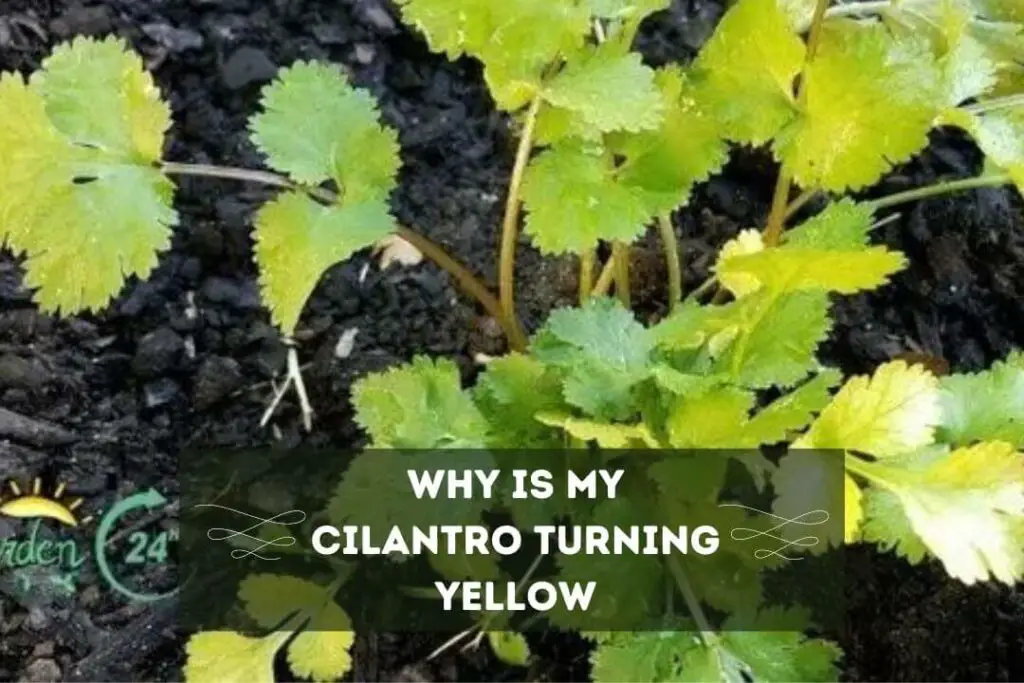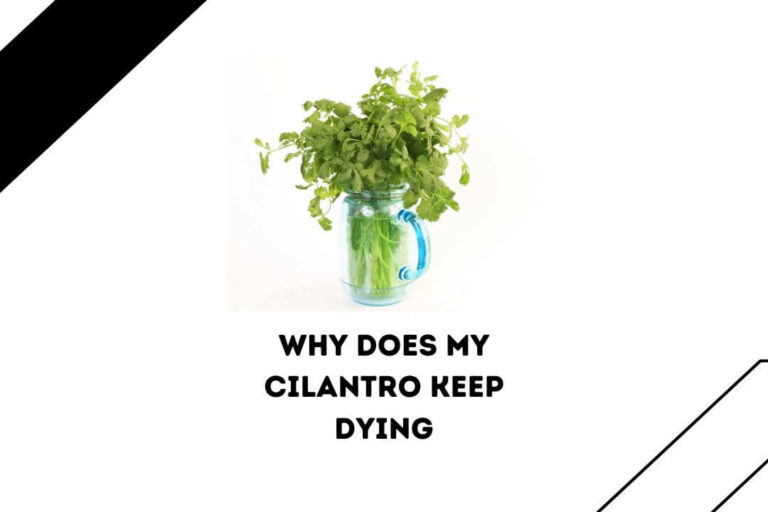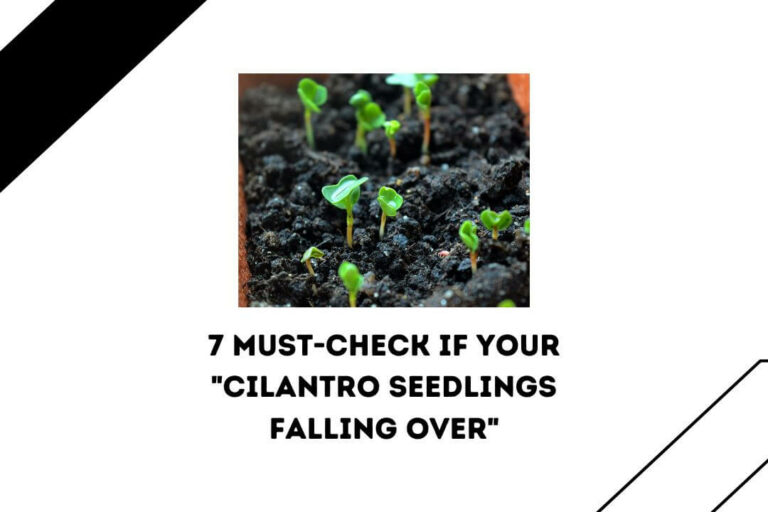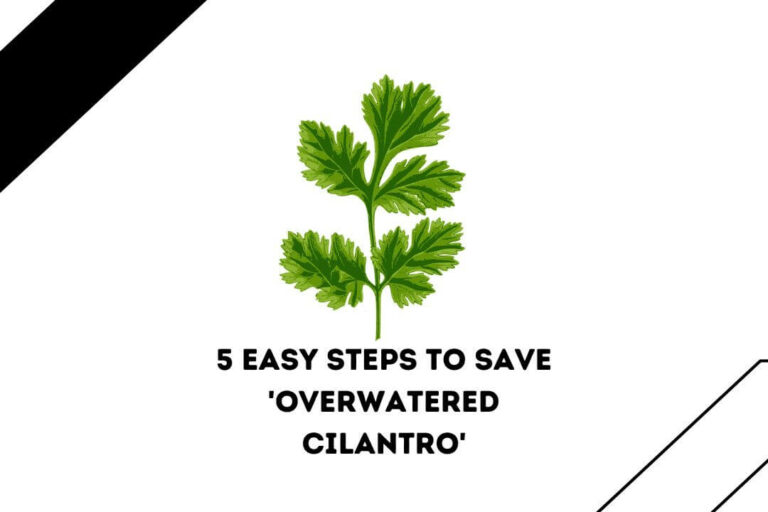If you are growing a cilantro plant in your garden, you might feel concerned if it changes color. Don’t worry if you are wondering why my cilantro plant is turning yellow, don’t worry because you are not alone.
Many gardeners, even professionals, have experienced this problem once in their lifetime. Before you worry too much, there are a few things that you can do. But before that, it is essential to understand the common causes of yellowing Cilantro plants and how to fix a particular issue depending on the grounds.
If you are looking for ways to get your cilantro plant back to its green and healthy state, read this article thoroughly, where we have discussed seven significant reasons why it turns yellow.
7 Major Reasons Why Is My Cilantro Turning Yellow

Overwatering
One of the most common causes of cilantro plants turning yellow is often said to be Overwatering. If you continue watering your cilantro plant twice, it can lead to root rot, which not only causes the plant to turn yellow and wilt.
As to the University of Michigan Extension, you must provide well-drained soil to your cilantro plants with a pH range of 6.0-6.5. Other Signs of overwatering include leaves turning yellow, brown, or black and the stem becoming soft and mushy.
If this is the case, you must stop watering your cilantro plant. You should only water your plant if the top inch of soil feels dry. Never mind dipping your index finger a few inches deep into the ground to see if it is moist or dry. If your plant is already overwatered, then you need to follow a different approach. To do this, never mind checking our other article on “How TO SAVE ‘OVERWATERED CILANTRO.”
Transplant shock
Another common reason for your cilantro plant to turn yellow could be directly related to transplant shock. If you recently transplanted your Cilantro, it might be undergoing transplant shock.
As per NYBG, you should never transplant Cilantro or relocate them until it reaches 2-3 inches tall and the soil is warm. The most common signs of transplant shock include yellowing leaves and stunted growth. If this is causing your cilantro plant to turn yellow, I recommend you pay attention & give extra care to your transplanted Cilantro.
Nutrient Deficiency
As per expert requirements, you should fertilize your cilantro plant every 2-3 weeks with balanced fertilizers that contain nitrogen, Phosphorus, and potassium in the same proportion, like 10-10-10 fertilizer.
If your Cilantro lacks any nutrients like nitrogen, Phosphorus, or potassium, it might not be able to grow correctly and achieve its actual color. If your cilantro plant suffers from nutrient deficiency, you should also notice slow growth accompanied by yellowing leaves.
If this is the case, consider using a balanced fertilizer specially made for cilantro plants. Before you add any fertilizer to the soil, take a sample and get it tested by a lab to determine what it lacks and how much fertilizer you need to provide. Alternatively, you can take the help of a soil testing kit that is widely available in small stores and online.
Aging plant
Since Cilantro is an annual herb with a short lifespan, it is common to turn yellow and eventually die naturally. As the cilantro ages, it will naturally turn yellow and die.
However, if you want a continuous harvest, you can always replant Cilantro every 2-3 weeks. To determine if your cilantro plant is suffering from yellowing due to aging or not considered, look at its stems. Cilantro plant yellow leaves are likely to be accompanied by dry branches. If this is the case, I recommend you consider replanting new Cilantro.
Pest & diseases
Like any other plant, your Cilantro is susceptible to pests and diseases like aphids, mites, and fungal infections. Maybe the pest infestation or condition is causing your cilantro plant to turn yellow and wilt.
If this is the case, you must use insecticide or fungicide according to the type of disease or paste you treat on your cilantro plant. You should know that keeping the plant clean and using organic pest control can prevent most pests and conditions.
You will notice discoloration in the cilantro plant and spots on its leaves if it suffers from pest infestation or any other type of disease.
Underwatering
You might be underwatering your cilantro plant (opposite to overwatering), leading to yellow leaves. You should know that Cilantro needs cool temperature & consistent moisture to grow well.
A Lack of water will undoubtedly cause the leaves to turn yellow after drying. If your cilantro plant leaves turn yellow and hang, it needs water. In addition to this, if you feel the soil is dry to the touch, make sure to water it. It is also essential to ensure the ground drains well and not waterlogs.
Temperature stress
As I told you earlier, most types of Cilantro prefer cool temperatures and can quickly become stressed in hot weather. If you live in a region with Extreme temperatures, your cilantro plant will turn yellow and die. However, if you are struggling with Cilantro keeps dying or cilantro seedlings falling over, other factors can be involved/at play.
As the New York botanical garden recommends, you should grow Cilantro in a temperature range between 50-70°F. If your cilantro plant is suffering from temperature stress, you will notice its leaves color yellow and wilted a lot.
If so, you should consider moving your Cilantro to a more fantastic location. If you have grown this cilantro plant in a pot, you can quickly move it to a more relaxed place. On the other hand, if your cilantro plant is on the ground, protect covers. You can try giving mulching around the base of your Cilantro plant to prevent soil moisture from getting depleted.
How To Fix Cilantro Yellowing?
- Before fixing the problem, you must first identify the cause. As I told you, yellowing cilantro plants could be caused by overwatering, underwatering, nutrient deficiency, pests and diseases, temperature stress, transplant shock, and aging plants. Therefore, look for signs of each cause to take appropriate action.
- After determining the actual cause, you must immediately take action to save your Cilantro. You might need to adjust your watering schedule if the reason is overwatering or underwatering; read this. You must ensure that the soil stays moist and well-draining but not soggy is essential.
- Similarly, if you find the actual cause to be a nutrient deficiency, provide a balanced fertilizer. Even though you think this is not the cause, you still need to deliver balanced fertilizer with equal proportions of nitrogen, Phosphorus, and potassium to improve cilantro health.
- In many cases, the cause of the yellowing is simply pests or diseases. If this is the king,, I first recommend you consider using organic pest control methods and switch to commercial options.
- If you cannot get your cilantro yellowing, I recommend replanting it. Make sure to choose well-draining soil and a location that receives the proper amount of sunlight & shade.
Hey there, If you are wondering why my cilantro looks like a dill?, read this article where we have discussed five reasons and what you should do.
Preventing Cilantro Plants from Turning Yellow
- Always Choose the right location: that receives the right amount of sunlight with partial shade.
- Ensure to water your Cilantro consistently without letting the soil become waterlogged. I will recommend you aim for ground that is moist but not soaked.
- Always choose a balanced organic fertilizer that contains equal parts nitrogen, Phosphorus, & potassium.
- I will highly advise you to look for signs of pests like aphids, mites, or whiteflies and treat them promptly.
- When harvesting, you’re cutting from the outer edges of the cilantro plant, leaving the center intact to continue growing. But if it is grown in an aero garden, here is how to harvest cilantro aerogarden?
Note: Avoid overcrowding your plants, as this can lead to disease. In rare cases, cilantro may also turn red, which is not tasty. If this is the case, read this article to learn tips on saving red cilantro plants.
FAQ
What To Do With Potted Cilantro Turning Yellow?
If your potted Cilantro is turning yellow, identify the cause of the problem and take action promptly. You must consider adjusting your watering schedule, providing proper nutrients, controlling pests & diseases, and replanting if necessary.
Can You Eat Yellow Cilantro Leaves?
Yes, you can eat yellow cilantro leaves as they are entirely safe. However, you will not experience the same flavor as green Leaves. Do note that cilantro plants turning yellow can be a sign that the plant is stressed or aging, which can affect the taste & texture of the leaves.
Related Cilantro Plant Topics
| Did You Knew About Tiny Bugs On Cilantro Plant? |
| How Many Cilantro Per Square Foot? |
| WHAT DOES CILANTRO LOOK LIKE WHEN IT SPROUTS? |
Conclusion
As I told you in this article, there can be mainy reasons why your cilantro plant is yellowing. Maybe you are not watering your cilantro plant properly or your plant is in direct sunlight for too long.
Also, high temperature, improper care, or nutrient deficiency can also lead to yellowing cilantro plants. You should take the action only after determining the actual culprit. If you find this article helpful where I have shared all the information you need to get your Cilantro back to its normal state, consider sharing it.
Your share will help many people learn what they are doing wrong,, leading to yellow cilantro plants. Do check our other helpful guide on cilantro care and management. See you in the next post till then take care and goodbye.






